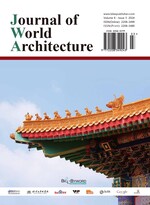Abstract
Green building is a manifestation of the response to the national “dual carbon” strategy. With the large-scale promotion of green buildings, the country has successively issued multiple evaluation standards for green buildings. Schools are places for preaching, teaching, and solving doubts, and the campus environment plays an important role in improving students’ learning efficiency and promoting their physical and mental health. This article is based on the “Green Building Evaluation Standards” GB/T 50378-2019, analyzing and exploring the integration and application of key technologies in green schools, providing reference for green building designers.
References
Ministry of Housing and Urban Rural Development of the People’s Republic of China, 2019, Green Building Evaluation Standards, GB/T 50378-2019, viewed June 14, 2024.
Li R, Wang R, 2017, Analysis of Building Energy Efficiency Design in Xizang: Taking the Small Enterprise Incubation Base in Qushui Industrial Park as an Example. Green technology, 2017(2): 111–114.
Zhang Y, He Z, 2020, Brief Analysis of the Development and Application of Green Building Design and Green Energy-Saving Buildings. Iranian Journal of Science and Technology-Transactions of Civil Engineering, 48(2): 1131–1141.
Li Y, Liu Z, Li C, 2022, Review of Government Strategies on Green Building in Singapore. Journal of Green Building. 17(4): 219–241.
Mushi FV, Huba N, Kihila J, 2022, A Critical Review of African Green Building Research. Building Research and Information, 50(6): 610–627.
Lai F, Zhou J, Lu L, et al., 2023, Green Building Technologies in Southeast Asia: A Review. Sustainable Energy Technologies and Assessments, 55: 102946.
Abdelaal F, Guo BHW, 2021, Knowledge, Attitude and Practice of Green Building Design and Assessment: New Zealand Case. Building and Environment, 2021(201): 107960.
Ohueri CC, Bamgbade JA, Liew ASC, et al., 2022, Best Practices in Building Information Modelling Process Implementation in Green Building Design: Architects’ Insights. Journal of Construction in Developing Countries, 27(1): 79–93.
Deng Y, Xiao S, Sun Q, et al., 2022, Integrated Optimization Design of School Buildings Based on Green Building Technology: A Case Study of Shuiquan Primary School and Kindergarten in Tai’an City. Journal of Shandong Agricultural University (Natural Science Edition), 53(6): 941–946.
Ding J, 2024, Research on Planning and Design of Primary and Secondary School Buildings: Taking the Project of Yuexi County Chengxi Compulsory Education School as an Example. Anhui Architecture, 2024(02): 26–27 + 79.
Fu W, Cong L, Shen J, et al., 2024, Research on the Suitability Technical System for Green Renovation of Existing School Buildings: Taking Kaiyuan Middle School in Hangzhou as an Example. Urban Architecture, 2024(02): 144–148.
Li Z, Wu K, Cao J, et al., 2024, Comparative Study of Evaluation Standards for Green and Low Carbon Buildings between China and Foreign Countries: A Comparative Study of Evaluation Standard Systems between China and Germany. Construction Technology, 2024(07): 58–60 + 72.
Zhang Y, 2023, Research on the Application of Green Ecological Technology: Taking a Residential Project in Baoding City as an Example. Green Buildings.2023(4): 40–42.
Ministry of Housing and Urban Rural Development, 2015, Technical Regulations for Building Applications, JGJ 113-2015, viewed June 14, 2024.
National Development and Reform Commission, 2003, Notice on Issuing the Regulations on the Management of Building Safety Glass, viewed June 14, 2024. https://www.ndrc.gov.cn/fzggw/jgsj/yxj/sjdt/200511/t20051128_987828.html
Ministry of Housing and Urban Rural Development, 2015, Design Code for Concrete Structures, GB 50010-2010 (2015 Edition), viewed June 14, 2024.
Fang L, Wyon DP, Clausen G, et al., 2004, Impact of Indoor Air Temperature and Humidity in an Office on Perceived Air Quality, SBS symptoms and performance. Indoor Air, 14(7): 74–81.
Sekhar SC, 2016, Thermal Comfort in Air-Conditioned Buildings in Hot and Humid Climates – Why are We Not Getting it Right? Indoor Air, 26(1): 138–152. http://dx.doi.org/10.1111/ina.12184
Jin M, Liu S, Schiavon S, et al., 2018, Automated Mobile Sensing: Towards High-Granularity agile Indoor Environmental Quality Monitoring. Building and Environment, 127: 268–276.
China Sports Daily, 2017, Interpretation of the National Fitness Guide, General Administration of Sport of China, viewed June 14, 2024. https://www.sport.gov.cn/n315/n331/n405/c819327/content.html
